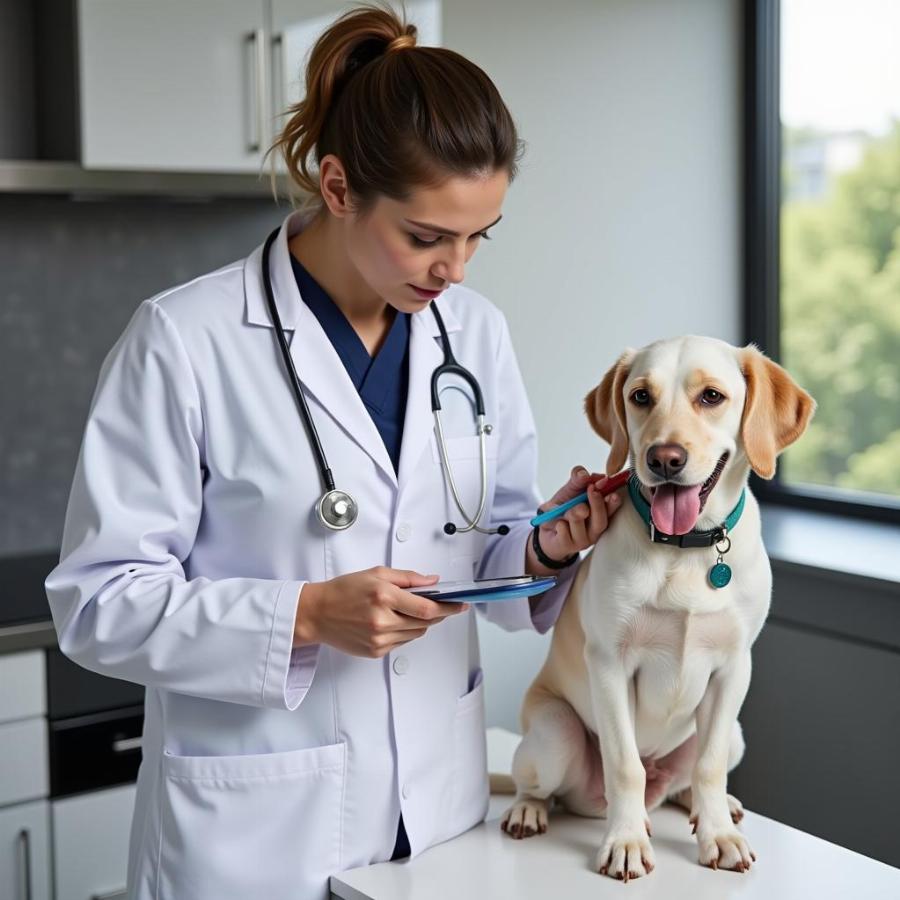Dog breeding up close involves understanding the intricacies of canine reproduction, genetics, and responsible breeding practices. It’s more than just bringing two dogs together; it’s about preserving breed standards, ensuring the health and well-being of the puppies, and contributing to the overall betterment of the canine world. Choosing to breed your dog is a significant commitment that requires careful planning, extensive research, and a deep understanding of the responsibilities involved.
Understanding the Basics of Dog Breeding Up Close
Breeding dogs involves more than just the act of mating. It encompasses a range of factors, including selecting suitable breeding pairs based on health, temperament, and conformation to breed standards. A thorough understanding of canine genetics is crucial to minimize the risk of inherited diseases and promote desirable traits. Responsible breeders prioritize the health and welfare of their dogs above all else, ensuring proper pre-breeding health screenings, appropriate care during pregnancy and whelping, and diligent socialization of the puppies before they go to their new homes.
Health and Genetic Considerations in Dog Breeding
 Health Check for Dogs Before Mating
Health Check for Dogs Before Mating
Before breeding, it’s essential to conduct thorough health screenings for both the male and female dog. This includes testing for genetic diseases common to the breed, evaluating their overall physical condition, and ensuring they are free from any infectious diseases. This minimizes the risk of passing on hereditary health problems to the puppies and ensures that both parents are in optimal breeding condition. Responsible dog breeding up close involves a commitment to producing healthy and well-adjusted puppies.
Genetic Testing and its Importance
Genetic testing plays a vital role in responsible dog breeding. It allows breeders to identify potential genetic predispositions to certain diseases, such as hip dysplasia, progressive retinal atrophy, and von Willebrand’s disease. By understanding the genetic makeup of the breeding pair, breeders can make informed decisions about which dogs to breed and reduce the likelihood of producing puppies with these debilitating conditions.
The Role of Responsible Breeders in Dog Breeding Up Close
Responsible breeders play a critical role in maintaining breed standards and ensuring the ethical breeding of dogs. They dedicate significant time, resources, and effort to raise healthy, well-socialized puppies. They carefully screen potential owners to ensure that their puppies go to loving and suitable homes. dogs breeding up close involves a dedication to the long-term well-being of the breed and a commitment to responsible breeding practices.
Ethical Considerations in Dog Breeding
Ethical breeding involves prioritizing the welfare of the dogs above profit. Responsible breeders do not overbreed their dogs and provide appropriate veterinary care throughout the breeding process. They also ensure that the puppies are properly socialized and raised in a nurturing environment before they are placed in their forever homes.
The Importance of Early Socialization and Care
Early socialization is crucial for the development of well-adjusted puppies. Exposing puppies to a variety of sights, sounds, smells, and experiences during their critical developmental period helps them become confident and well-behaved adult dogs. Responsible breeders begin this process early, handling the puppies frequently and introducing them to new stimuli in a safe and controlled manner.
Conclusion
Dog breeding up close is a complex undertaking that requires a deep understanding of canine reproduction, genetics, and responsible breeding practices. By prioritizing the health and well-being of the dogs, responsible breeders contribute to the overall betterment of the canine world. It’s a commitment to preserving breed standards, producing healthy puppies, and ensuring that every dog finds a loving and forever home.
FAQ
-
What is the ideal age to breed a dog? Dogs should reach physical and emotional maturity before breeding, typically around two years of age.
-
How often can a dog be bred? It’s recommended to limit breeding to once a year to allow the female’s body to recover.
-
What are the signs of pregnancy in a dog? Signs include increased appetite, weight gain, enlarged nipples, and behavioral changes.
-
How long is a dog’s pregnancy? The gestation period for dogs is approximately 63 days.
-
What is involved in whelping? Whelping is the process of giving birth, and it requires careful monitoring and preparation.
-
How do I find a responsible breeder? Research breeders thoroughly, ask for references, and visit their facilities to assess the environment. amish breeding dogs can offer insights into specific breeding practices.
-
What are the legal implications of dog breeding? Familiarize yourself with local regulations regarding dog breeding and licensing.
Do you have more questions about dog breeding? Explore these related articles:
how to breed a dog in minecraft
why is my female dog whining all of a sudden
how to feed a dog in minecraft
Beaut Dogs: Your Trusted Source for Canine Information
Beaut Dogs is your one-stop resource for all things canine. We provide reliable and comprehensive information on dog breeds, care, and everything in between. When you need expert advice, contact us at Email: [email protected] to get detailed and accurate answers from our team at Beaut Dogs.